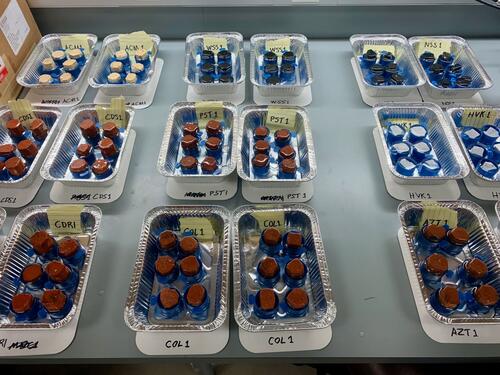Overview
 We created a set of well-characterized historical brick and geological specimens intended to aid the calibration of portable XRF (pXRF) instruments for archaeological ceramics. Known as the BRICC (Bricks and Rocks for Instruments’ Ceramic Calibration) sets, each of the ten matched sets consists of 20 specimens mounted in epoxy discs: 12 bricks and 8 geological specimens to use for calibration. Additionally, a certified reference material – a shale standard measured by 85 labs – is included with each set to assess the resulting accuracy, and a high-purity silica blank is included to check for spectral interferences or other calibration issues. The BRICC sets provide an open-source alternative to pXRF calibration approaches that are proprietary, were devised for oil shales instead of ceramics, and/or rely on expensive and often unavailable certified standards. A set can be tested at Yale or borrowed following loan policies of the Yale Peabody Museum. Publishing all information for the historical bricks and geological specimens – from their origins to the data used to derive the recommended values – fulfills the requirements of scientific transparency. Ultimately, these sets are intended and designed as a means (1) to meet (and exceed) experts’ practices regarding accuracy, reproducibility, and scientific transparency when analyzing ceramics using pXRF and (2) to reduce siloed production of knowledge within established laboratories and, hence, facilitate integration of more diverse perspectives into elemental studies of archaeological ceramics.
We created a set of well-characterized historical brick and geological specimens intended to aid the calibration of portable XRF (pXRF) instruments for archaeological ceramics. Known as the BRICC (Bricks and Rocks for Instruments’ Ceramic Calibration) sets, each of the ten matched sets consists of 20 specimens mounted in epoxy discs: 12 bricks and 8 geological specimens to use for calibration. Additionally, a certified reference material – a shale standard measured by 85 labs – is included with each set to assess the resulting accuracy, and a high-purity silica blank is included to check for spectral interferences or other calibration issues. The BRICC sets provide an open-source alternative to pXRF calibration approaches that are proprietary, were devised for oil shales instead of ceramics, and/or rely on expensive and often unavailable certified standards. A set can be tested at Yale or borrowed following loan policies of the Yale Peabody Museum. Publishing all information for the historical bricks and geological specimens – from their origins to the data used to derive the recommended values – fulfills the requirements of scientific transparency. Ultimately, these sets are intended and designed as a means (1) to meet (and exceed) experts’ practices regarding accuracy, reproducibility, and scientific transparency when analyzing ceramics using pXRF and (2) to reduce siloed production of knowledge within established laboratories and, hence, facilitate integration of more diverse perspectives into elemental studies of archaeological ceramics.
Publication
Read the peer-reviewed publication:
Frahm et al. 2022. Introducing the BRICC (Bricks and Rocks for Instruments’ Ceramic Calibration) sets: Open-source calibration materials for quantitative X-ray fluorescence analysis. Journal of Archaeological Science: Reports, 43, 103443, https://doi.org/10.1016/j.jasrep.2022.103443
Science Direct • ResearchGate • Academia.edu
Borrowing a Set
The BRICC sets are intended to be freely available to researchers via a loan (i.e., a temporary physical transfer without an ownership transfer) arranged with the Yale University Archaeological Laboratories, where most sets will reside. The precise loan policies will likely be re ned over time; however, the guidelines reflect those of Yale’s Peabody Museum of Natural History. Specifically, the loan of a BRICC set will be subject to the following stipulations:
- Loans are made for non-commercial and scholarly purposes (i.e., without financial gain; e.g., a borrower cannot charge someone a fee to calibrate an instrument with a loaned BRICC set). A loaned set will only be sent to an accredited educational or research institution.
- Loan requests should be made in writing on institutional letterhead. A request should state the purpose of the loan, a brief project description, where and under whose responsibility a set would be housed while on loan, and the requested length of the loan period.
- A loan is made to institutions, not individuals. Students, postdoctoral scholars, and visiting researchers cannot enter into formal agreements on behalf of their institutions. Therefore, a permanent faculty member or department head should submit a request on their behalf and assume responsibility, as an institutional representative, for the care and custody of a set. A set cannot be transferred to a third party without prior written authorization.
- Specimens in the set should not be sampled, remounted, or altered in any way. Many, but not all, of the BRICC specimens have corresponding unmounted material that may be requested, if a sufficient amount is available, for destructive compositional analyses.
As an alternative to a formal loan, qualified researchers may analyze a BRICC using their instrument during a scheduled visit to the Yale University Archaeological Laboratories.